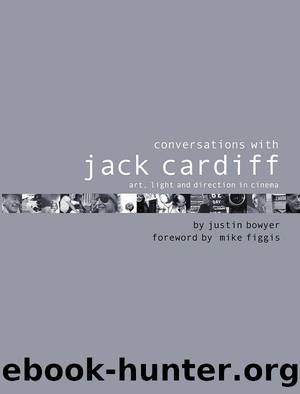Conversations With Jack Cardiff: Art, Light and Direction in Cinema by Justin Bowyer & Mike Figgis

Author:Justin Bowyer & Mike Figgis [Bowyer, Justin & Figgis, Mike]
Language: eng
Format: epub
Tags: Art, Autobiography, Biography, Cinema, Film, Individual Director, Non-Fiction, Performing Arts
ISBN: 9781849942539
Google: Hk-_CAAAQBAJ
Publisher: Pavilion Books
Published: 2014-11-12T00:00:00+00:00
Opposite: Jack Cardiff and Leslie Caron on location, Fanny (1960)
JBYou seem to feel that there are plenty of advantages to location work over studio shooting.
JCDefinitely! On location it brings everyone very much closer together, partly because they are forced to spend all of their time together. Locations are often very tough and can be quite horrific, and that is something that you have to go through together. Locations in the main are marvellous—you travel somewhere and you have to work hard. Tourists go back to their hotels at midday to escape from the heat, but film crews have to keep on working right through. It is always worth it.
JBHow were the Paris studio facilities at that time?
JCVery good. Quite excellent; in fact, they had everything.
JBHow did they compare to, say, Cinecittà in Rome that you had used for War and Peace?
JCRome was a different ballgame because they had these enormous studios at Cinecittà, but I had the feeling that they didn’t really have the facilities to make a series of big pictures, as they often relied on American productions, which came over and hired the studios. But on their own it was a pretty threadbare industry in Rome.
I had always admired the French technicians. Their system was not so hidebound as in England. At this time in England, the unions were very tough, so wherever we went we had to work by the rules very closely; otherwise, we were in deadly trouble. There was the story of a location shoot in Wales where the director wanted a door to be a different colour, and as they were in a hurry, they got the local painter to quickly paint it. When the studios found out, they stopped the production and had the studio painter come out and repaint the door.
It doesn’t happen so much now, but it certainly happened a lot in those days. So it was refreshing to be in Paris where, if you had a fairly logical argument why you wanted to take just one camera and an assistant out to shoot something quickly, then you could bend the rules and no one said a word—that’s what I liked about it.
JBThe film picked up a raft of award nominations20 and you were again Academy Award-nominated for your cinematography.
JCYes, that was very pleasant. I had been so happy to photograph it because it was wonderful to work on and the net result was that it looked good.
JBDid you go to the Academy Awards ceremony this time?
JCNo, I have never been to the ceremony when I have been nominated. As always, I was already working on another picture, and I really couldn’t afford the time for a long trip.
JBDid the nomination make you question your decision to be a director?
JCI don’t know; that’s an interesting question. Inside me, I wanted to continue to direct, but that all depended on what subjects came up; I was just waiting for another assignment. I suppose I was on a kind of ‘sticky wicket’ at
Download
This site does not store any files on its server. We only index and link to content provided by other sites. Please contact the content providers to delete copyright contents if any and email us, we'll remove relevant links or contents immediately.
Shoot Sexy by Ryan Armbrust(17133)
Portrait Mastery in Black & White: Learn the Signature Style of a Legendary Photographer by Tim Kelly(16478)
Adobe Camera Raw For Digital Photographers Only by Rob Sheppard(16380)
Photographically Speaking: A Deeper Look at Creating Stronger Images (Eva Spring's Library) by David duChemin(16151)
Bombshells: Glamour Girls of a Lifetime by Sullivan Steve(13100)
Art Nude Photography Explained: How to Photograph and Understand Great Art Nude Images by Simon Walden(12339)
Perfect Rhythm by Jae(4616)
Pillow Thoughts by Courtney Peppernell(3381)
The Book of Joy by Dalai Lama(3212)
Good by S. Walden(2909)
The Pixar Touch by David A. Price(2735)
Fantastic Beasts: The Crimes of Grindelwald by J. K. Rowling(2540)
A Dictionary of Sociology by Unknown(2516)
Humans of New York by Brandon Stanton(2376)
Read This If You Want to Take Great Photographs by Carroll Henry(2299)
Stacked Decks by The Rotenberg Collection(2266)
On Photography by Susan Sontag(2126)
Photographic Guide to the Birds of Indonesia by Strange Morten;(2086)
Insomniac City by Bill Hayes(2080)
